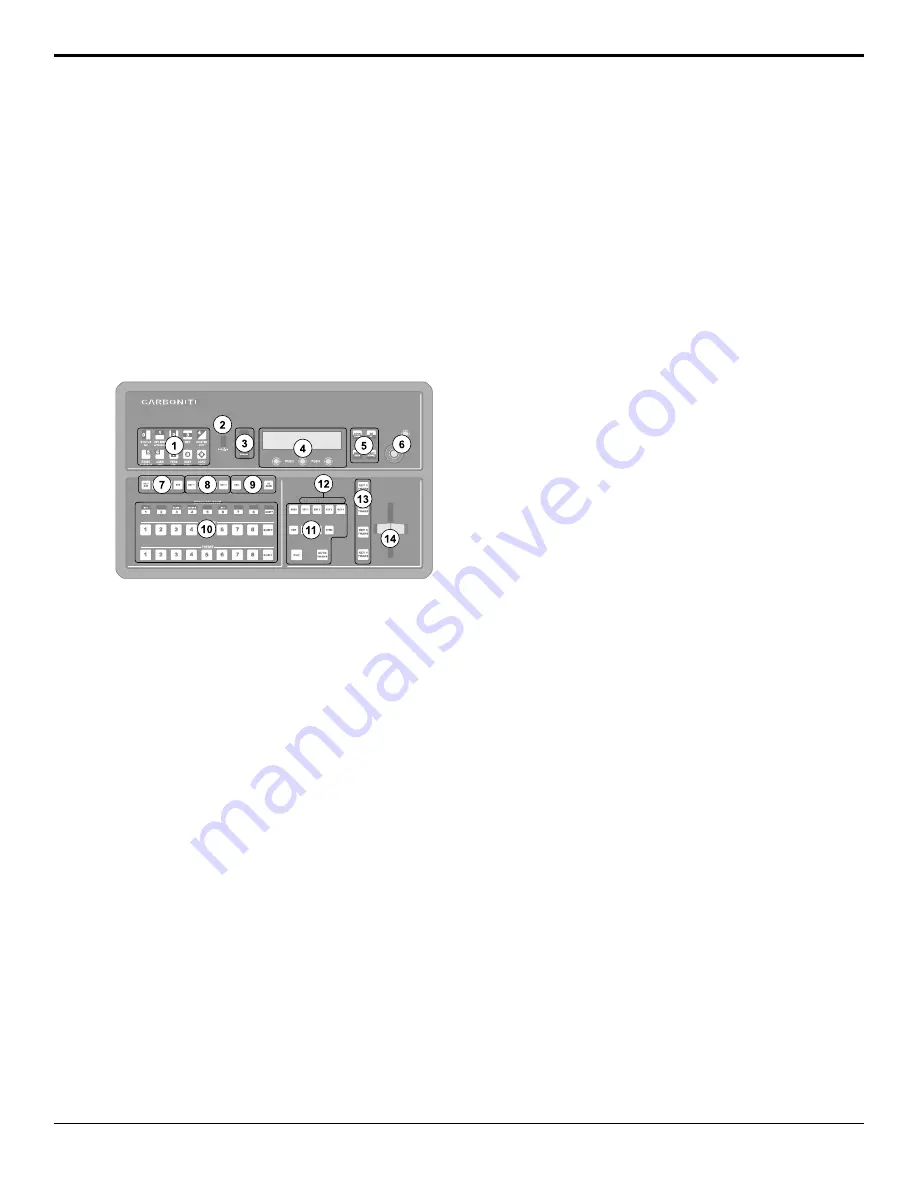
16.
Manual Transition Fader Bar
— The fader is
used to manually control the rate of a transition.
What is being transitioned, and the type of
transition, are controlled from the Transition Area.
17.
Keyer Transitions Buttons
— These buttons are
used to perform cuts or auto transitions on keys
directly, without having to include them as part of
the next transition.
CB9 Panel Top
The CB9 control panel is made up of a number of
distinct areas that control different aspects of the
switcher.
Figure 4: Carbonite Black Solo Panel Top
1.
Pattern/Menu Selection Buttons
— These
buttons are used to select a pattern for a wipe
transition, or to access switcher menus.
2.
USB
— The USB port on the control panel is used
for upgrades and media files. .
3.
Memory Store/Recall Buttons
— These buttons
are used to store or recall memories.
4.
Main Display and Selection Knobs
— The
three selection knobs are used to adjust and select
various menu items or values. The knobs are
rotated to choose a value, and pressed to make
a selection. The main display shows the menu
system of the switcher.
5.
Menu Navigation Buttons
— These buttons are
used to access switcher menus, move back and
forth between menus.
6.
Positioner
— The positioner is used to control
some wipe, border, and wash parameters, as well
as some external devices. Along with the 2D
positioner is a knob used for additional input.
7.
Key Type Buttons
— These buttons are used to
choose the type of key you want to use. Use these
buttons with the key select buttons to select the
keyer, and the type of key you want to use.
8.
Keyer Select Buttons
— By default these user
select buttons are used to select which keyer the
panel is assigned to. Each button can be assigned
to a different selection.
9.
User Select Buttons
— These user select
buttons are used to choose which keyer, aux bus,
MiniME
™
, ME, or custom control bank the panel
is assigned to.
10.
Video Source Buses
— These buses are broken
into the Preset, Program, and Key/Aux/Custom
Control buses. The Preset bus is the bottom row
of source buttons and selects the video source
that will be taken on-air with the next background
transition. The Program bus is the middle row of
source buttons and selects the video source that
is currently on-air on the background. The Key/
Aux/Custom Control bus is the top row of source
buttons and selects the video source that is chosen
on the selected keyer or aux bus, or the custom
control that is chosen on the selected custom
control bank.
11.
Transition Area
— These buttons are used to
select which video source buses will be included
in the next transition and what type of transition
will be performed. The Cut and Auto Trans
buttons are used to perform transitions.
12.
On-Air Lights
— These lights glow red to show
which keyers are currently on-air.
13.
Keyer Transitions Buttons
— These buttons are
used to perform auto transitions on keys directly,
without having to include them as part of the next
transition.
14.
Manual Transition Fader Bar
— The fader is
used to manually control the rate of a transition.
What is being transitioned, and the type of
transition, are controlled from the Transition Area.
Carbonite Black Operation Manual (v14.0) — Control Panel Overview •
13
Содержание Carbonite Black Series
Страница 1: ...Carbonite Black Operation Manual v14 0...




























